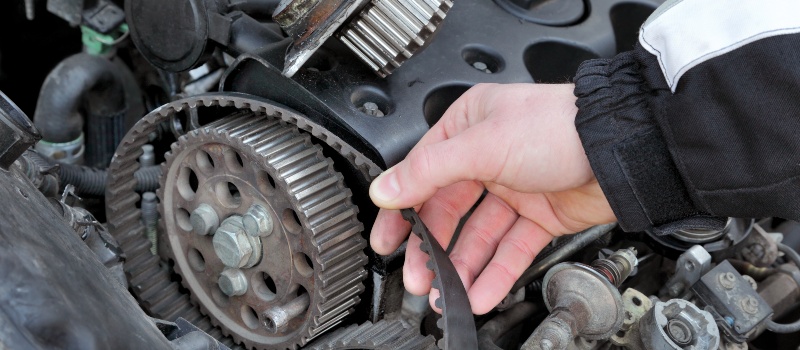
What is cam belt failure?
13th Feb, 2020
If you’ve taken the car parts quiz we recently published on our blog, you might be feeling pretty confident on your knowledge of car components. One component you may have spotted is the timing chain – otherwise known as the cam belt.
It’s not a part that everyone can identify, but while humble in appearance, it’s absolutely vital to the smooth functioning of your engine. In fact, it’s so important that if it ever breaks, rather than going to the cost of replacing your engine (which can cost thousands of pounds), it’s often easier to say scrap my car. So, you may be wondering, what exactly does a cam belt do, and why is it so important?
What is a cam belt and what does it do?
At its core, a cam belt (or timing chain) is basically a rubber band with teeth, and its job is to keep your engine running by ensuring that vital components stay out of each other’s way. How does it do this? Well, there’s a short answer and a long answer. The short version is that it synchronises the rotation of the camshaft and the crankshaft, which stops your engine from destroying itself.
To give you the long answer, we’ll have to give you a quick crash course (excuse our phrasing) on how a car’s engine works. Most car engines are reciprocating engines, which means they use pistons to generate motion. As the pistons move up and down, they suck air and fuel into the space above them, and compress this mixture – which then ignites when the piston hits the top of its rotation, causing a small explosion which propels the piston back down. This generates energy, which helps the engine to generate motion, which ultimately generates movement.

So where does the cam belt come in? We’re getting to it! Now, these pistons are obviously travelling at dizzying speeds when you’re driving, and there’s a small set of valves above each one. Their job is to let just the right amount of gas in and out to keep the fuel/air mixture consistent, which keeps the pistons moving, which keeps the car in motion. By the time the piston reaches the top of each rotation, these valves need to be almost closed or entirely so. If the piston collides with either of these valves, the results can be catastrophic, and quite often fatal for the engine.
The cam belt is the part that stops this happening. By synchronising the rotation of the cam shaft and the crankshaft, it ensures that these valves stay out of the way of the pistons, so that everything runs smoothly and efficiently.
What happens if the cam belt breaks
Like many of us, a car engine really struggles to get through the day without a belt. The most likely outcome, as you’ve probably concluded, involves catastrophic damage to your engine. In most cases, the pistons will collide with the valves, which will bend them out of shape or even break them. Or it could be the valves themselves that do the damage, by punching through the piston cap. (It certainly sounds cool, but if you’re the owner it’s really not.) Small fragments of metal can start bouncing around the inside of your engine, or even be pulled through to the exhaust. You don’t need to be a professional mechanic to realise why that might not be the best news.

Some cars might have what’s known as a non-interference engine – essentially, one which doesn’t involve the internal components slamming into each other without the proper safeguards. With these sorts of engines, you might be able to manage for a short time without a cam belt – but it’s likely that your car will become a lot less efficient in the meantime, so it’s still not something to ignore if you can help it.
How to prevent cam belt problems
Simple – make sure you get your car properly serviced! When manufacturers put the car together, they include an estimate for the operational life of the various components. In the case of the cam belt, its lifespan will generally be determined by the mileage, but since it’s rubber it can also degrade with time as well. So if you’ve not driven your car in a while, it’s never a bad idea to think about getting it quickly serviced before you hit the open roads!
Are there any early warning signs of a broken cam belt?
Here’s the kicker – not really. The cam belt is so deeply embedded into the engine that it’s difficult to spot problems emerging with it, unless it’s being checked as part of an overall service of the car. If you’re driving when it breaks, you might notice a rattling or slapping noise, but it’s likely that the consequences will become apparent quickly anyway – for example if shrapnel does indeed start bouncing around on the inside of your engine.
Sadly, if that happens, the cost for a replacement engine usually runs into the thousands of pounds, which often exceeds the cost of the vehicle. In this case, often the most economical thing to do is to scrap your car. While it might not be a particularly happy day when that comes, you can at least rest assured that here at Scrap Car Network, we’ll do everything we can do make the process as easy and simple as possible for you. All you have to do is enter your car reg and postcode into the fields on our site, and you can find out how much your car is worth in as little as 10 seconds! Go on – couldn’t hurt to look, could it?